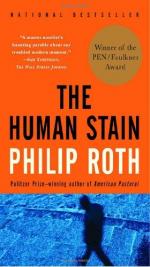|
This section contains 8,687 words (approx. 29 pages at 300 words per page) |

|
SOURCE: Safer, Elaine B. “Tragedy and Farce in Roth's The Human Stain.” Critique 43, no. 3 (spring 2002): 211-27.
In the following essay, Safer interprets The Human Stain as a commentary on the “political correctness fever” during the 1990s and outlines the tragic and farcical elements of the novel.
Philip Roth has called his recent three novels “a thematic trilogy.” They all deal, he explains, with the “historical moments in postwar American life that have had the greatest impact on my generation”: the McCarthy era, the Vietnam War, and 1998, the year of Bill Clinton's impeachment (McGrath, “Interview” 8).1
In American Pastoral (1997), a handsome, honest, hardworking businessman and Jewish athletic hero, Seymour (“Swede”) Levov, is ruined by the actions of daughter Merry, an anti-Vietnam War activist, who “brings the war home” to folks in New Jersey by setting off a bomb in the local post office. In I Married a Communist (1998), a radio...
|
This section contains 8,687 words (approx. 29 pages at 300 words per page) |

|


